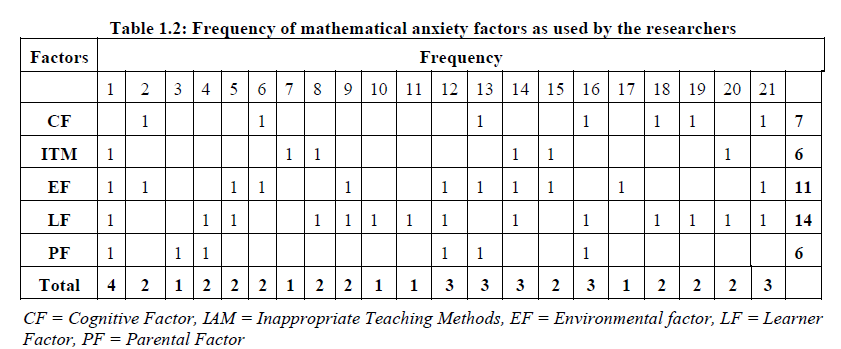Introduction
Math anxiety is a widespread and complex phenomenon that deserves special attention in the field of education and psychology. This article explores the connection between math anxiety and academic achievement, drawing on international scientific research for analysis
Given the significance and widespread impact of this phenomenon, we found it important to explore further into the topic. This includes examining the causes and manifestations of math anxiety and exploring five potential intervention and treatment strategies for primary and secondary school teachers.
The proposed solutions aim not only to mitigate students’ anxiety, but also to promote a more positive and inclusive learning environment. We will explore how these strategies can be effectively integrated into everyday educational practice, offering concrete guidelines for educators, parents and education professionals interested in improving students’ math learning experience.
What is Math Anxiety?
Math anxiety is defined as an emotional distress resulting from situations in which a student is faced with mathematical stimuli. Such specific anxiety interferes with the ability to solve mathematical problems not only in school settings but also in everyday contexts.
From a cognitive-behavioral perspective: Math anxiety can be defined as a multidimensional construct that includes cognitive, affective, and behavioral components. It manifests as a sense of tension, apprehension, or fear that interferes with mathematical performance in various contexts, from daily life to academic situations. This anxiety can lead to avoidance strategies, procrastination, and a decrease in mathematical self-efficacy, creating a cycle of negative reinforcement that affects learning and long-term performance (Ashcraft, 2002).
However, math anxiety, or MA, should not be confused with the more common generalized anxiety or anxiety preceding an exam. Maths anxiety is a widespread phenomenon among students of all ages and can manifest itself in various ways, such as nervousness, fear or high stress during learning and performing mathematical tasks (Ashcraft, 2002; Ashcraft and Ridley, 2005). According to research conducted by KPMG UK, more than 35 percent of people in the UK say that performing calculations makes them anxious, while one in five (20 percent) are almost scared (2023).
However, having math anxiety does not mean that a student is not good at math. Therefore, it is crucial to address the problem effectively and help students who, throughout their academic journey have internalized negative concepts about the subject and themselves.
In addition, a recent meta-analysis published in 2021 (Barroso et al.) confirms the correlation between MA and poor academic achievement leading to lower achievement in reasoning and problem solving (Bandalos et al., 1995; Ashcraft and Kirk, 2001; Ashcraft, 2002; Cates and Rhymer, 2003).
Factors Contributing to Math Anxiety.
Math anxiety is a complex phenomenon: often the fear of failing to solve math problems is accompanied by a feeling of confusion or disorientation associated with cognitive factors associated with the home environment such as interaction with parents and siblings or the school environment.
Kour & Zia (2024) in their meta-analysis study analyzed 40 scientific papers to identify the factors behind the problem. Below is a summary table from which it appears that the predominant cause according to their study is not unique; on the contrary, cognitive, environmental, and educational factors may play their part.

Kour & Rafaqi (2024). Factors Affecting Mathematical Anxiety: A Systematic Review of Related Literature.
- (LF) LEARNER FACTOR: 14: This is the highest scoring factor. This includes a frustration at not being able to understand concepts, the related self-perception (devaluing) causing a chain reaction in students of avoidance toward the subject.
- (EF) ENVIRONMENTAL FACTOR: 11: concerns the education provided by reference figures within the home and in the classroom. For example, low socio-cultural level of family members or excessive pressure received during classwork causes negative emotions.
- (CF): COGNITIVE FACTOR: Fear of failing a complex problem, especially when related to standardized tests, and parenting style can both influence math anxiety. Parents may convey negative emotions toward the subject. Similarly, a teacher who shows little enthusiasm for the subject can contribute to the problem.
5 Strategies For Math Teachers To Reduce Math Anxiety.
In a previous blog post we showed 4 strategies for teachers to create a culture that welcomes and incites mistakes through the growth mindset. Lecturers should foster an atmosphere in which mistakes are accepted and are seen as learning opportunities rather than failures.
Below, you will find five strategies for primary and secondary schools to reduce math anxiety, supported by scientific research.
1. Awareness of the Problem
Are you a middle or high school math teacher? The first step should be to gather information regarding the health of your classroom. Here are some tools:
- Specific Questionnaires: Consider using open-ended or semi-structured questionnaires to gauge the emotional state of your class. Click this link to find out about the Mathematical Anxiety Rating Scale (MARS), or its abbreviated version, AMAS—an internationally recognized survey for assessing math anxiety.
- Brainstorming: ask to be supported by a specialist psychotherapist or pedagogue. Brainstorming sessions will help you understand what emotions students feel about math. Anger? Fear? Happiness? Your students will be able to get rid of some emotions and perhaps start on a new path.
- Body Language Observation: Learn to observe your students’ body language for valuable insights. Signs like sweaty palms, visible nervousness, or avoidant behavior may indicate underlying math anxiety.
2. Inclusive Teaching Methods.
Using diverse teaching methods can play a significant role. Presenting mathematics through visual components makes the material more accessible and understandable, reducing the perception of abstractness that often generates uncertainty and anxiety. Practical examples and real-world applications actively engage students in the learning process, allowing them to manipulate mathematical concepts through diagrams, models and simulations. This active involvement reduces the anxiety associated with passivity and fear of the unknown.
Respecting students’ different innate learning modalities-visual, auditory and kinaesthetic-allows them to choose the method that best suits their preferences, reducing feelings of abstractness and confusion. Practical examples help develop a better understanding of mathematical concepts and see the connection between theory and practice, increasing confidence in one’s ability to solve mathematical problems and reducing anxiety associated with the fear of failure.
3. Pay Attention to Your Words
“Teachers’ comments can have both positive and negative effects on students’ self-esteem. By projecting a positive attitude towards mathematics and expressing the belief that all students can and should succeed in math, educators can significantly improve students’ perceptions of the subject.”
| Instead of Saying | Try Saying |
| This one is easy! | 1.This problem is similar to the one X already carried out. 2. This problem will be solved in X steps 3. No rush. Take your time. |
| How come you don’t know? | 1.I know math can be difficult.
I get stuck sometimes too, and when I do, I try to do that. 2.It’s okay not to know the answer right away. Try looking at your notes, previous work, or examples. |
4. Provide Constructive and Timely Feedback
Provide constructive feedback by offering clear directions on how to correct errors. This improves their learning without discouraging the student. For example, rather than simply telling them that they made a mistake in a calculation, a teacher might explain exactly where the error was made and illustrate an alternative method of solving the problem. This kind of feedback not only helps students better understand mathematical concepts, but also encourages them to persevere and continuously improve their skills without feeling judged.
5. Reducing Memorization Of Concepts
In the field of mathematics pedagogy, a traditional approach has often focused on simply memorizing concepts and procedures.
Procedural memorization tends to emphasize repetition and the ability to remember specific steps to solve problems. Although this approach may provide immediate results in terms of solving specific problems, it may reduce students’ motivation. Students may feel compelled to memorize formulas and procedures without a full understanding of the underlying concepts, which can lead to poor practical application and a loss of interest and confidence in the long run.
On the contrary, understanding the “why” behind a formula or method helps develop superior cognitive skills. This type of learning not only improves their math skills, but also helps them develop a genuine interest in the subject by increasing their self-efficacy and self-esteem (Boaler, J. 2015)
Students feel more confident in their abilities when they are able to apply mathematical concepts in different contexts and solve problems using their critical and creative thinking. In this way, they not only improve their academic performance, but also their intrinsic motivation to learn and grow in the field of mathematics.
Conclusions
Reducing math anxiety is a significant challenge in the contemporary educational context, but it is also an achievable goal thanks to evidence-based approaches in modern pedagogy.
By employing pedagogical approaches that honor diverse learning styles and encourage active student participation, you can reduce anxiety and foster math learning that goes beyond rote memorization. In conclusion, collaboration among educators, therapists, pedagogists, families, and students is crucial for effectively implementing these strategies and creating a positive, inclusive learning environment for everyone
Bibliography
Ashcraft, M. H., Kirk, E. P. (2001). The relationships among working memory, math anxiety, and performance. Journal of Experimental Psychology, 130(2), 224-237.
Young, C. B., Wu, S. S., Menon, V. (2012).
Caviola, S., Carey, E., Mammarella, I. C., Szucs, D. (2021). Stress, time pressure, strategy selection and math anxiety in mathematics: A review of the literature. Frontiers in Psychology, 12, 1-15.
Devine, A., Hill, F., Carey, E., Szűcs, D. (2018). Cognitive and emotional math problems largely dissociated: Prevalence of developmental dyscalculia and mathematics anxiety. Journal of Educational Psychology, 110(3), 431-444.
Maloney, E. A., Beilock, S. L. (2012). Math anxiety: Who has it, why it develops, and how to guard against it. Trends in Cognitive Sciences, 16(8), 404-406.
Kour, S. J., Rafaqi, M. Z. H. (2024). Factors affecting mathematical anxiety: A systematic review of related literature. Rajasthali Journal.
Ramirez, G., Shaw, S. T., Maloney, E. A. (2018). Math anxiety: Past research, promising interventions, and a new interpretation framework. Educational Psychologist, 53(3), 145-164.

